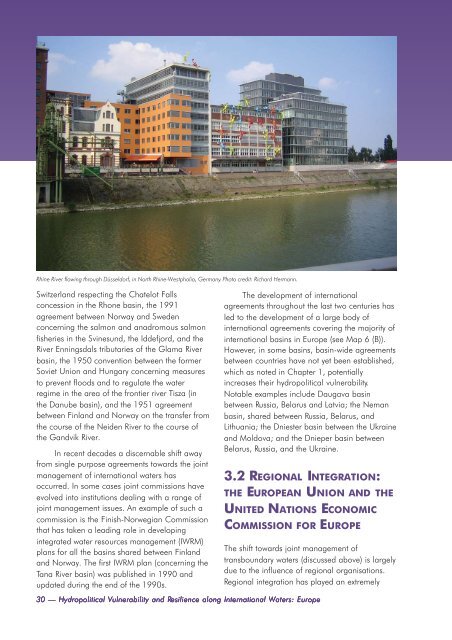Europe - UNEP
Europe - UNEP
Europe - UNEP
You also want an ePaper? Increase the reach of your titles
YUMPU automatically turns print PDFs into web optimized ePapers that Google loves.
Rhine River flowing through Düsseldorf, in North Rhine-Westphalia, Germany. Photo credit: Richard Hermann.<br />
Switzerland respecting the Chatelot Falls<br />
concession in the Rhone basin, the 1991<br />
agreement between Norway and Sweden<br />
concerning the salmon and anadromous salmon<br />
fisheries in the Svinesund, the Iddefjord, and the<br />
River Enningsdals tributaries of the Glama River<br />
basin, the 1950 convention between the former<br />
Soviet Union and Hungary concerning measures<br />
to prevent floods and to regulate the water<br />
regime in the area of the frontier river Tisza (in<br />
the Danube basin), and the 1951 agreement<br />
between Finland and Norway on the transfer from<br />
the course of the Neiden River to the course of<br />
the Gandvik River.<br />
In recent decades a discernable shift away<br />
from single purpose agreements towards the joint<br />
management of international waters has<br />
occurred. In some cases joint commissions have<br />
evolved into institutions dealing with a range of<br />
joint management issues. An example of such a<br />
commission is the Finish-Norwegian Commission<br />
that has taken a leading role in developing<br />
integrated water resources management (IWRM)<br />
plans for all the basins shared between Finland<br />
and Norway. The first IWRM plan (concerning the<br />
Tana River basin) was published in 1990 and<br />
updated during the end of the 1990s.<br />
The development of international<br />
agreements throughout the last two centuries has<br />
led to the development of a large body of<br />
international agreements covering the majority of<br />
international basins in <strong>Europe</strong> (see Map 6 (B)).<br />
However, in some basins, basin-wide agreements<br />
between countries have not yet been established,<br />
which as noted in Chapter 1, potentially<br />
increases their hydropolitical vulnerability.<br />
Notable examples include Daugava basin<br />
between Russia, Belarus and Latvia; the Neman<br />
basin, shared between Russia, Belarus, and<br />
Lithuania; the Dniester basin between the Ukraine<br />
and Moldova; and the Dnieper basin between<br />
Belarus, Russia, and the Ukraine.<br />
3.2 REGIONAL INTEGRATION:<br />
THE EUROPEAN UNION AND THE<br />
UNITED NATIONS ECONOMIC<br />
COMMISSION FOR EUROPE<br />
The shift towards joint management of<br />
transboundary waters (discussed above) is largely<br />
due to the influence of regional organisations.<br />
Regional integration has played an extremely<br />
30 — Hydropolitical Vulnerability and Resilience along International Waters: <strong>Europe</strong>
















